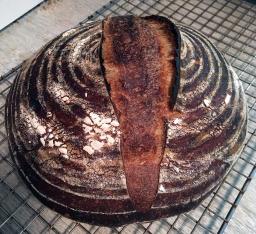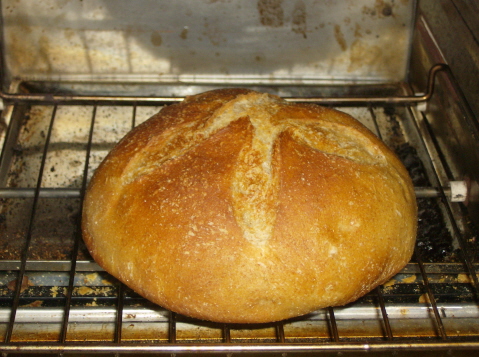This bread is based on the Italian Bread formula in Peter Reinhart's “Bread Baker's Apprentice.” I substituted a biga naturale (sourdough starter) for the biga made with instant yeast in Reinhart's formula. I still added the instant yeast to the final dough to provide more predictable fermentation and proofing times.
Reinhart recommends this formula for hoagie rolls. I divided the dough to make 4 rolls scaled to 4 ounces each and shaped the remainder of the dough into one large bâtard.
I also employed the “stretch and knead in the bowl” technique during bulk fermentation, even though I used a KitchenAid mixer for mixing beforehand.


Intermediate starter (Biga naturale)
|
Active starter
|
3 oz.
|
|
Water
|
9 oz.
|
|
KAF Bread flour
|
12 oz.
|
Final Dough
|
Biga naturale (Note: save the remaining 6 oz. for another bread.)
|
18 oz.
|
|
KAF Bread flour
|
11.25 oz.
|
|
Salt
|
0.41 oz. (1-2/3 tsp)
|
|
Sugar
|
0.5 oz. (1 T)
|
|
Instant yeast
|
0.11 oz (1 tsp)
|
|
Diastatic barley malt powder
|
0.17 oz. (1 tsp)
|
|
Olive oil
|
0.5 oz (1 T)
|
|
Water at 80F
|
7 oz (¾ cup)
|
|
Sesame seeds for coating.
Semolina to dust the parchment paper.
|
|
Mix and ferment the biga.
Mix the biga naturale the evening before baking. Dissolve the starter in the water in a medium sized bowl, then add the flour and mix thoroughly to hydrate the flour and distribute the starter. Cover the bowl tightly and allow to ferment for 3-6 hours, until it doubles in volume. Refrigerate overnight.
The next day, remove the biga from the refrigerator and allow it to warm up for an hour or so. Alternately, mix the biga late at night and ferment at room temperature overnight.
Mix the dough
Mix the flour, salt, sugar, yeast and malt powder in a large bowl or the bowl of your mixer. Add the biga in pieces, olive oil and ¾ cups of tepid water and mix thoroughly. Adjust the dough consistency by adding small amounts of water or flour as necessary. The dough should be very slack at this point.
I mixed the dough with the dough hook in the KA mixer for 10 minutes then transferred it to an 8 cup/2 liter glass pitcher that had been lightly oiled.
Fermentation
I stretched and folded the dough in the pitcher with a rubber spatula then covered it tightly. I repeated the stretch and fold again 20 and 40 minutes later. I then left the dough to ferment until it was double the original volume (45-60 minutes more).
Divide and form
Divide into 2 pieces and pre-form as logs. Allow the dough to rest 5 minutes or more, then form into bâtards. To make rolls, divide into 4 ounce pieces and pre-shape into rounds, then shape into torpedos. If desired, spray or brush the loaves with water and sprinkle with sesame seeds.
Prepare a couche – either a floured piece of baker's linen or parchment paper sprinkled with semolina.
Pre-heat the oven to 500F with a baking stone on the middle shelf. Make preparations for steaming the oven.
Place the loaves in the couche, cover with plastic or a towel and allow to proof until 1-1/2 times their original size (about 40 minutes).
Baking
Score the loaves and transfer them to the baking stone. Bake with steam, using your favorite method. After loading the loaves and steaming, turn the over down to 450F and bake until done (about 20 minutes for a bâtard, 15 mnutes for rolls.). If you want a thicker crust, use a lower temperature and bake for longer.
Cooling
Allow to cool before slicing, if you can.

Sourdough Italian Roll

Sourdough Italian Roll crumb
We had a couple of the rolls for lunch. They were very nice. The crust is chewy, not crunchy, and the crumb is also chewy. This is not your fluffy, cottony roll that seems standard in most sub shops and, unfortunately, most Italian delis.
I am pretty sure this is the roll I would choose for a meatball sandwich, oozing mozzarella and dripping marinara sauce. I don't think this roll would be the usual soggy mess after the first 20 seconds. However, in the interest of Science, I will volunteer to test this hypothesis. Of course, if additional volunteers were to pool their data with mine, we can be more confident of our conclusions.
David
Submitted to Yeast Spotting on Susan FNP's marvelous Wild Yeast blog






